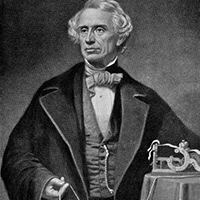Samuel F.B. Morse
Inventor of the Telegraph and Morse Code
Like a lot of other American inventors, Samuel F.B. Morse was fairly eclectic in his interests. He was a well-known portrait painter and the first president of the National Academy of Design. He also ran for office several times, patented three new pumps and studied electricity. Ultimately, his interests would lead him to his most famous accomplishment: inventing the electric telegraph.
Inspired by a conversation he overheard about electromagnetism on a ship ride from Europe, inventor Samuel Morse conceived the idea for an electric telegraph (though, unbeknownst to him, the idea was not exactly new). The concept of his invention was that pulses of electricity could be used to communicate information over wires.
Though not part of the original design, the invention came to include a dot-and-dash code that used different numbers to represent the letters of the alphabet. In time, this newly invented code would become known as "Morse Code."
With the aid of some partners, Samuel F.B. Morse applied for a patent for his new invention and went to work building a prototype. Not long after, Morse was transmitting ten words per minute with the device at a New York exhibition.
In May 1844, Morse sent a message ("What Hath God Wrought!") from Washington to Baltimore using the first inter-city electromagnetic telegraph line in the world. Soon after, the telegraph invention would become commonplace across the United States and, eventually, throughout the world.
For more information on inventor Samuel F.B. Morse's telegraph and Morse Code inventions, please visit:
White River Valley Museum: Morse Code History
Locust Grove: The Samuel F.B. Morse Historic Site
Inventor Samuel Morse: Telegraphy & Morse Code

